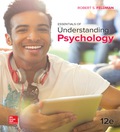
To match: The name of each brain scan with the appropriate description.
Answer to Problem 1E
Correct answer:
| a. EEG | 2. Electrodes placed around the skull record the electrical signals transmitted through the brain. |
| b. fMRI | 3. This technique provides a three-dimensional view of the brain by aiming a magnetic field at the body. |
| c. PET | 1. By locating radiation within the brain, a computer can provide a striking picture of brain activity. |
Explanation of Solution
a. EEG - 2. Electrodes placed around the skull record the electrical signals transmitted through the brain.
The electroencephalogram (EEG) is a major brain-scanning technique used to record electrical activity in the brain by placing electrodes around the skull. The electrodes detect and record the electrical signals that are transmitted through the brain.
b. fMRI - 3. This technique provides a three-dimensional view of the brain by aiming a magnetic field at the body.
The functional magnetic resonance imaging (fMRI) is a major brain-scanning technique that provides a clear and detailed three-dimensional computer-generated image of brain structures and activity. It is a painless and safe test that uses radio waves and magnetic field to create detailed images of the brain and brain stem.
c. PET - 1. By locating radiation within the brain, a computer can provide a striking picture of brain activity.
The positron emission tomography (PET) is a major brain-scanning technique used to show biochemical activity within the brain at a particular time. This scanning process locates radiation within the brain, and then provides a striking picture of brain activity through a computer.
Want to see more full solutions like this?
Chapter 7 Solutions
EBK ESSENTIALS OF UNDERSTANDING PSYCHOL
- What are three methods for dissemination of information that school counselors can use after watching the YouTube video titled “The Effective School Counselor with a High-Risk Teen: Motivation Interviewing Demonstration” (https://www.youtube.com/watch?v=_TwVa4utpII) by MerloLab (MerloLab, 2015)? Please write in a narrative format and include citations.arrow_forwardWhat are the three most important knowledge a school counselor can gain from watching the YouTube video titled: “The Effective School Counselor with a High-Risk Teen: Motivation Interviewing Demonstration” (https://www.youtube.com/watch?v=_TwVa4utpII) by MerloLab (MerloLab, 2015)? Please write in a narrative format and include citations.arrow_forwardWhat are the three most relevant principles school counselors need to be aware of watching the YouTube video titled: “The Effective School Counselor with a High-Risk Teen: Motivation Interviewing Demonstration” (https://www.youtube.com/watch?v=_TwVa4utpII) by MerloLab (MerloLab, 2015)? Please write in a narrative format and include citations.arrow_forward
- I need help finding 16 research artices on big 5 personality test on a attractiveness of those with tattos an those with out tattosarrow_forwardI need help with what is evolution to psychology cultural can you describe it in you own wordsarrow_forwardI need help finding 16 research articles on noncomformnitity on attractiviness of a person with tattos an with out tattosarrow_forward
- What follows the psychoeducational assessment and the role the preschool teacher can play? Use scholarly sources.arrow_forwardWhat is psychoeducational assessment, how is it conducted, and why is it more appropriate for assessing the needs of a child with undiagnosed special needs. Use scholarly sources.arrow_forwardI need help finding 16 peer view research articles on japan that talks about the values respect ad group harmony, which explains the people's behavior that can differ in the socieries that differ in there valuing of collectivismarrow_forward
- how to answer these 2 question for revision Required reading: • McKevitt, G. (2024, September 2). https://www.bbc.com/culture/article/20240829-the-life-changing-day-world-war-two-beganarrow_forwardable to help me with this question for resivison purpose with references in apa To test your application of the knowledge gained from this course, develop an individualperformance plan (no longer than one page) to help you to present well for the workshop Your performance plan should clearly appraise specific and personal performance challengesthat you may face when delivering the workshop. Please identify at least 2 performancechallenges that are specific for you, and analyse why they may be challenging for you. Applyyour understanding of this course and suggest some specific and practical strategies that willhelp you to present well during the workshop.arrow_forwardable to help me with this question for resivison purpose To test your application of the knowledge gained from this course, develop an individualperformance plan (no longer than one page) to help you to present well for the workshoppresentation component of your ECA (Q2). Your performance plan should clearly appraise specific and personal performance challengesthat you may face when delivering the workshop. Please identify at least 2 performancechallenges that are specific for you, and analyse why they may be challenging for you. Applyyour understanding of this course and suggest some specific and practical strategies that willhelp you to present well during the workshop.arrow_forward
 Ciccarelli: Psychology_5 (5th Edition)PsychologyISBN:9780134477961Author:Saundra K. Ciccarelli, J. Noland WhitePublisher:PEARSON
Ciccarelli: Psychology_5 (5th Edition)PsychologyISBN:9780134477961Author:Saundra K. Ciccarelli, J. Noland WhitePublisher:PEARSON Cognitive PsychologyPsychologyISBN:9781337408271Author:Goldstein, E. Bruce.Publisher:Cengage Learning,
Cognitive PsychologyPsychologyISBN:9781337408271Author:Goldstein, E. Bruce.Publisher:Cengage Learning, Introduction to Psychology: Gateways to Mind and ...PsychologyISBN:9781337565691Author:Dennis Coon, John O. Mitterer, Tanya S. MartiniPublisher:Cengage Learning
Introduction to Psychology: Gateways to Mind and ...PsychologyISBN:9781337565691Author:Dennis Coon, John O. Mitterer, Tanya S. MartiniPublisher:Cengage Learning Psychology in Your Life (Second Edition)PsychologyISBN:9780393265156Author:Sarah Grison, Michael GazzanigaPublisher:W. W. Norton & Company
Psychology in Your Life (Second Edition)PsychologyISBN:9780393265156Author:Sarah Grison, Michael GazzanigaPublisher:W. W. Norton & Company Cognitive Psychology: Connecting Mind, Research a...PsychologyISBN:9781285763880Author:E. Bruce GoldsteinPublisher:Cengage Learning
Cognitive Psychology: Connecting Mind, Research a...PsychologyISBN:9781285763880Author:E. Bruce GoldsteinPublisher:Cengage Learning Theories of Personality (MindTap Course List)PsychologyISBN:9781305652958Author:Duane P. Schultz, Sydney Ellen SchultzPublisher:Cengage Learning
Theories of Personality (MindTap Course List)PsychologyISBN:9781305652958Author:Duane P. Schultz, Sydney Ellen SchultzPublisher:Cengage Learning





